
Sailing California Coast in the ’70s, Pt. 2
The following is Part 2 of a dispatch of John Tysell’s sail from San Diego to San Francisco in 1979 (Click here for Part I):
The biggest challenge of my trip from San Diego to San Francisco with my girlfriend Gwynne Crouse was rounding Point Conception, known for strong wind and nasty seas. On advice from a fellow sailor who had taken this route, we left the Santa Barbara Yacht club at midnight and motored westward in the Santa Barbara Channel. We took turns driving, and saw lights on the oil platforms through the fog. After dawn, the wind came up and we raised our sails and donned our foul-weather gear. As the wind and waves were building, we rounded Point Conception just before noon and reefed the main. By 3 p.m., we had navigated Point Arguello and began our beat due north to San Luis Harbor. Arriving well after dark, we dropped the anchor and collapsed into our warm sleeping bags.

We woke to a warm, clear day with little wind, so we cranked up the Atomic Four gasoline engine and departed Avila Beach. Leaving the Diablo Canyon Nuclear Plant to starboard, we reached the entrance to Morro Bay late in the day when the engine died, and I was unable to restart it. We hoisted sail, but made little headway as the current was running out of the harbor. Hailing the harbormaster on the VHF, I was able to request a tow to the Morro Bay Yacht Club. After spending the night, we found an engine mechanic who got the motor working, but never discovered the problem. Pressing on, we sailed to San Simeon Cove, and anchored with a view of Hearst Castle.
Following an early breakfast, I glanced at the chart and plotted a compass course to the west. After a few minutes, I was hailed to come topside — there were breaking waves. Sure enough, I had missed a reef on the chart which lay dead ahead. Passing Point Piedras Blancas, the wind filled in from the south and I hoisted the spinnaker for a nice downwind sail up the coast of Big Sur. Approaching a large kelp bed, we needed to jibe the sail and head out to sea. With Gwynne steering, I was able to, singlehanded, dip the pole from starboard to port at the last moment and avoid the kelp.

There were no safe harbors along that stretch of shore for 100 miles, so we sailed well into the night before getting to Monterey Harbor. We docked in the nearest slip available. At roughly midnight, the harbormaster kicked us out of our cozy slip and we had to drop the hook near Fisherman’s Wharf.
Even after getting up later than usual in the morning, there was still fog and only a slight breeze. Cruising across Monterey Bay, we were joined by a pod of dolphins frolicking across the bow. After motoring several hours and passing Santa Cruz, we heard a loud clank. The engine had quit for good. I later learned that the old Atomic Four had thrown a rod.
As we sailed on in a light wind, night fell and the fog rolled in — pea-soup fog. I tacked in toward shore looking for the lighted buoy off the entrance to Half Moon Bay. Soon I heard waves crashing on the beach and the depth sounder displayed 22 feet. An immediate tack saved us from being caught in the surf.
Wanting to stay offshore, we had to cross the shipping lanes. It was pitch black. I hoisted the radar reflector, and soon heard the loud thumping of a partially submerged prop of a large ship — but I couldn’t see any running lights. Quickly going below, I returned with life jackets and flare guns. Fortunately, the noise of the turning screw slowly disappeared.

Dead reckoning had been abandoned hours before. Now, I needed to find out where we were, and GPS would not be invented for another 15 years. A radio direction finder (RDF) locates a transmission source of a radio station by the direction when the signal is the weakest (the null point). The tower is then located on the chart and the bearing plotted. A second line is projected based on the depth curve and a position fixed. We were several miles off Montara.
After sailing all night, the sky started to brighten and the fog lifted. The Golden Gate Bridge was a welcome sight as the sun came up in the east and we made our way back to Richmond Yacht Club.
Gwynne Crouse, my girlfriend at the time who started the trip as a novice, was now an experienced sailor. She would be part of my crew when we did the San Francisco to Kauai race in 1980. We married in 1981, and have two children and two grandchildren.
